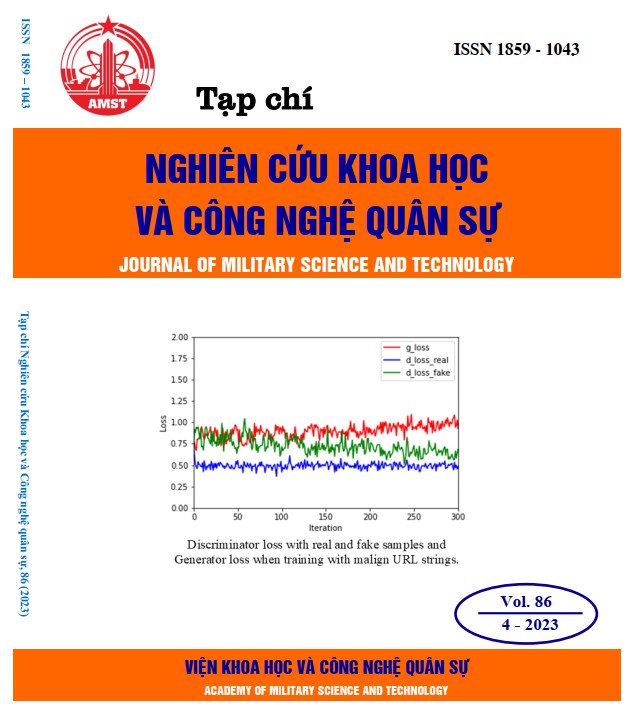Đánh giá khả năng khử mùi chuồng trại chăn nuôi của môt số chủng vi sinh phân lập từ quần đảo Trường Sa
430 lượt xemDOI:
https://doi.org/10.54939/1859-1043.j.mst.86.2023.79-85Từ khóa:
Vi khuẩn dị dưỡng; Oxi hóa ammonia; Oxi hóa sulfide.Tóm tắt
Nghiên cứu này phân lập được 4 chủng có hoạt tính oxi hóa H2S và 6 chủng có hoạt tính oxi hóa NH3 từ các mẫu đất, nước thải chăn nuôi trên quần đảo Trường Sa. Chủng vi khuẩn có khả năng khử khí gây mùi từ chuồng trại chăn nuôi (H2S, NH3) được sàng lọc, sử dụng môi trường khoáng dịch thể thiosulfate có bổ sung nguồn cơ chất cao nấm men, glucose và môi trường khoáng Vinograxki có bổ sung glucose, citrate. Kết quả thu được cho thấy, chủng được phân lập có khả năng làm giảm pH trong môi trường nuôi cấy xuống pH 4 – pH 5, khả năng chịu nồng độ NaCl 30 g/l, chịu nhiệt phù hợp với điều kiện trên các đảo thuộc quần đảo Trường Sa. Trong đó, chủng AOBN4 có hiệu suất xử lý ammoni đạt 73% và chủng SOBS9 có khả năng chuyển hóa thiosulfate thành ion sulfate đạt 5,9 mg/ml. Kết quả này cho thấy, các chủng phân lập được có hiệu quả khử mùi và có tiểm năng để ứng dụng cho sản xuất chế phẩm khử mùi cho hoạt động chăn nuôi trong điều kiện biển đảo.
Tài liệu tham khảo
[1]. Rameshkumar P., “Microbiological and molecular characterization of sulfur oxidizing Pseudomonas sp. PRK786 isolated from cattle manure compost”, International journal of Advanced Research, Vol. 2, No.3, pp. 714 – 722, (2018).
[2]. Hidayat M.Y., “Isolation and characterization of Sulphur oxidizing bacteria isolated from hot spring in Malaysia for biological deodorization of hydrogen sulfide in chicken manure”, Media Peternakan, Vol. 40, No 3, pp. 178 – 187, (2017). DOI: https://doi.org/10.5398/medpet.2017.40.3.178
[3]. Hou N., “H2S biotreatment with sulfide oxidizing heterotrophic bacteria”, Biodegradation, Vol. 29, No 6, pp. 511-524, (2018). DOI: https://doi.org/10.1007/s10532-018-9849-6
[4]. Behera B.C., “Sulphur oxidizing bacteria in mangrove ecosystem: a review”, African Journal of Biotechnology, Vol. 13, pp. 2897 – 2907, (2015). DOI: https://doi.org/10.5897/AJB2013.13327
[5]. Chen X.G., “Isolation and characterization of sulfur oxidizing Thiomonas sp. and its potential application in biological deodorization”, Letters in Applied Microbiology, Vol. 39, pp. 495 -503, (2004). DOI: https://doi.org/10.1111/j.1472-765X.2004.01615.x
[6]. Takenaka S., “Isolation and characterization of thermotolerant bacterium utilizing ammonium and nitrate ions under aerobic conditions”, Biotechnol Lett, 29, pp. 385 – 390, (2007). DOI: https://doi.org/10.1007/s10529-006-9255-8
[7]. Hee-Wook Ryu, “Thermophilic biofiltration of H2S and isolation of a thermophilic and heterotrophic H2S-degrading bacterium, Bacillus sp. TSO3”, Journal of Hazardous Materials, Vol. 168, pp. 501–506, (2009). DOI: https://doi.org/10.1016/j.jhazmat.2009.02.046
[8]. Li H., “Isolation and evaluation of endophytic Bacillus tequilensis GYLH001 with potential application for biological control of Magnaporthe oryzae”. PLOS one, (2018), DOI: https://doi.org/10.1371/journal.pone.0203505. DOI: https://doi.org/10.1371/journal.pone.0203505
[9]. Yang Y., “Heterotrophic nitrogen removal in Bacillus sp. K5: involvement of a novel hydroxylamine oxidase”, Water science and technology, pp. 1-8, (2017). DOI: https://doi.org/10.2166/wst.2017.510
[10]. Yang, X. P., “Isolation and nitrogen removal characteristics of an aerobic heterotrophic nitrifying-denitrifying bacterium, Bacillus subtilis A1”, Bioresource Technology, Vol. 102, No. 2, pp. 854–862, (2011). DOI: https://doi.org/10.1016/j.biortech.2010.09.007
[11]. Yao, Y. C., “Simultaneous removal of organic matter and nitrogen by a heterotrophic nitrifying-aerobic denitrifying bacterial strain in a membrane bioreactor”, Bioresource Technology, Vol. 43, pp. 83–87, (2013). DOI: https://doi.org/10.1016/j.biortech.2013.05.120
[12]. Sato, “Analysis of malodorous volatile substances of human waste: feces and urine”, Journal of health science, Vol. 47, No. 5, pp. 483-490, (2001). DOI: https://doi.org/10.1248/jhs.47.483
[13]. Yao, R. L., “Isolation and characteristics of heterotrophic nitrification-aerobic denitrification bacterium, Bacillus cereus X7 at high salinity”, Environmental Engineering, Pts 1- 4, pp. 111-114, (2014). DOI: https://doi.org/10.4028/www.scientific.net/AMR.864-867.111
[14]. Dai J, “Production of highly active extracellular amylase and cellulase from Bacillus subtilis ZIM3 and a recombinant strain with a potential application in tobacco fermentation”, Frontiers in Microbiology, Vol. 11, No. 1539, pp. 1-14, (2020). DOI: https://doi.org/10.3389/fmicb.2020.01539
[15]. Kim, “Enhancement of microbial nitrification to reduce ammonia emission from poultry manure: a review”, World's Poultry Science Journal , Vol. 70, No. 4, pp. 839 – 856, (2014). DOI: https://doi.org/10.1017/S0043933914000890
[16]. Ardiansyah, “The selected facultative mixotrophic sulfur oxidizing bacteria from intensive shrimp ponds”, AACL Bioflux, Vol. 13, No. 5, pp. 2886 -2896, (2020).
[17]. Zhang Duoying, “Isolation, Identification and Characterization of heterotrophic nitrifying bacteria from surface water”, Advanced aterials Research, Vol. 726, pp. 406 – 411, (2013). DOI: https://doi.org/10.4028/www.scientific.net/AMR.726-731.406







